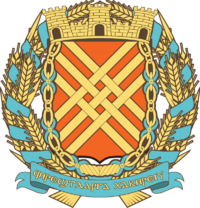Girbetese Constitution of 1976: Difference between revisions
No edit summary |
|||
| Line 30: | Line 30: | ||
*Constitution of the Tichvaist Union of Girbeta of 1957 | *Constitution of the Tichvaist Union of Girbeta of 1957 | ||
}} | }} | ||
The '''1976 Girbetese Constitution''' is the basis for all laws in the [[Girbeta|Tichvaist Union of Girbeta]]. Developed in the aftermath of the [[ | The '''1976 Girbetese Constitution''' is the basis for all laws in the [[Girbeta|Tichvaist Union of Girbeta]]. Developed in the aftermath of the [[Vanugalu Conflict]] and the [[Kučkullanu]], as well as a wave of general civil disobedience and labor upheavals from the late 1960s on, The Constitution was developed in recognition of the failings of the original 1957 Constitution, as cited by the Special Committee for Democracy in the Union from their investigations into the causes of the conflicts. | ||
The Committee stated the Constitution's shortcomings included failures to protect vulnerable and historically-disadvantaged populations, increasing isolation of communities, and an executive branch that, while ideally intended to ensure popular control of the government, effectively was a weak rubber stamp position subservient to the Principal Elder. Upon their report to the National Consultative Assembly in February of 1976, a vote of both houses of the Assembly authorized the establishment of the Special Committee for Constitutional Reform, a panel of respected Girbetese statesmen and political theorists from around the world which was placed in charge of developing a new constitution which "married the spirit and ideals of 1956 with the practical needs of a modern developing society". | The Committee stated the Constitution's shortcomings included failures to protect vulnerable and historically-disadvantaged populations, increasing isolation of communities, and an executive branch that, while ideally intended to ensure popular control of the government, effectively was a weak rubber stamp position subservient to the Principal Elder. Upon their report to the National Consultative Assembly in February of 1976, a vote of both houses of the Assembly authorized the establishment of the Special Committee for Constitutional Reform, a panel of respected Girbetese statesmen and political theorists from around the world which was placed in charge of developing a new constitution which "married the spirit and ideals of 1956 with the practical needs of a modern developing society". | ||
Revision as of 14:38, 24 May 2020
| Second Constitution of the Tichvaist Union of Girbeta of 1976 | |
|---|---|
 Chief Deputy Irek Bassem (left) shakes hands with Principal Elder Sabrican Labadi (right) at the signing of the 1976 Constitution on 8 July of that year. | |
| Jurisdiction | |
| Created | 1 May - 3 July 1976 |
| Presented | July 3, 1976 |
| Ratified | July 8, 1976 |
| Date effective | December 22, 1976 |
| System | Federal multi-party ecclesiocratic-republican semi-presidential republic |
| Branches | Three |
| Chambers | Bicameral (National Consultative Assembly); divided into two houses: the Chamber of Elders (Upper House), and Chamber of Deputies (Lower House) |
| Executive | Executive Secretariat led by a Executive Secretary |
| Judiciary |
|
| Federalism | Federal |
| Entrenchments | Three |
| Amendments | Seven |
| Last amended | August 9, 2002 (7th) |
| Location | National Archives, Saybäketle National Municipal Region, Girbeta |
| Author(s) |
|
| Signatories | All members of the CERC, CEDU, and the 39 members of the Chamber of Elders |
| Supersedes |
|
The 1976 Girbetese Constitution is the basis for all laws in the Tichvaist Union of Girbeta. Developed in the aftermath of the Vanugalu Conflict and the Kučkullanu, as well as a wave of general civil disobedience and labor upheavals from the late 1960s on, The Constitution was developed in recognition of the failings of the original 1957 Constitution, as cited by the Special Committee for Democracy in the Union from their investigations into the causes of the conflicts.
The Committee stated the Constitution's shortcomings included failures to protect vulnerable and historically-disadvantaged populations, increasing isolation of communities, and an executive branch that, while ideally intended to ensure popular control of the government, effectively was a weak rubber stamp position subservient to the Principal Elder. Upon their report to the National Consultative Assembly in February of 1976, a vote of both houses of the Assembly authorized the establishment of the Special Committee for Constitutional Reform, a panel of respected Girbetese statesmen and political theorists from around the world which was placed in charge of developing a new constitution which "married the spirit and ideals of 1956 with the practical needs of a modern developing society".
The resulting document dramatically reformed the government of the Federation, most strikingly by establishing the National Secretariat of Girbeta as a separate entity from the Legislature, as well as implementing a number of measures to develop its modern form of semi-direct democracy. It additionally affirmed an emphasis on local government and greater municipal autonomy, while also creating the current framework of national government which works to balance both the secular and religious elements of the nation. Accompanying these political reforms were broad protections for minorities in the country, a "workers' bill of rights", and guarantees for other human rights not originally included in the First Constitution.
Background
History
Legal standing
Contents
Preamble and Assertion of Sovereignty
The peoples of the Girbetese nation have maintained a distinct identity and continuity of statehood throughout the course of their collective history, from the Babaran exodus to modern times. This fact is asserted and made manifest by:
- The formation of the Point Faial Concord between the Babarans and Loaloa upon the arrival of the former in 1402;
- The establishment of Great Saybäketle in 1430;
- The connection of the disparate Loaloa tribes with Babaro-Girbetese settlers in the Achvitic Missions of Conversion, resulting in the development of the Tichva Confederacy;
- The formation of a joint Girbetese identity, its earliest records evident in the writings of the Revered Achvit Inaz Nakebak and his contemporaries in the 16th Century;
- Resilience of the Girbetese peoples and their identity in the face of the Miricio-Girbetese War;
- The heroic Defense of the Fortress of the Deliverance in 1601 and the assertion of a unified identity of the Girbetese peoples;
- The maintenance of the Girbetese and Loaloa languages, Girbetese custom, and Tichva throughout the Mirician Imperial Occupation;
- The assertion of our nation's natural right to self-determination made evident in the establishment of the Kingdom of Girbeta in 1866 and the subsequent reestablishment of an independent Girbetese state in 1951;
- The assertion of a uniquely Girbetese form of government rooted in popular sovereignty and Tichvaist customs in the Girbetese Revolution (1955), the establishment of our first Constitution (1956), the first set of national elections (1957), the defeat of the Monarchists (1955-1961), the victory over ethnic separatism in the Vanugalu Conflict (1968-1970), and our endurance of the Kučkullanu (1969-1976) and its subsequent victory against foreign influence in the Union;
- The spirit of reform which followed the Kučkullanu, resulting in the Constitutional Sessions of 1976 which sought to reform and assure the continuity of a free and democratic Tichvaist Union and to marry the spirit of 1956 with the practical needs of a modern developing nation and peoples.
Considering these presented historical facts, as well as the universal and undeniable principles of the modern world, affirm the right of the Girbetese peoples to indivisible, irrevocable, non-exhaustible and non-transferable right to self-rule, state sovereignty, including its fully-maintained right to secession and association. Thusly, as basic provisions to the maintenance of domestic peace, democracy, and the maintenance of a free international order of equals, this constitution establishes the Tichvaist Union of Girbeta as the nation-state of the Girbetese peoples: those of Babaran, Loaloa, Majulan, and Mirician ancestries, as well as the autochthonous national minorities which enrich our society: all peoples of the South Sea Islands, Frigidarites, [PATAGONIANS], Alydio-Miricians, and all others who are citizens, who are guaranteed all the full rights and protections inherent to all peoples of the Girbetese nation in accordance with the norms of democracy, human rights, individual freedoms, and all other protections affirmed through the Congress of Nations and the countries of the free world. Respecting the will of the Girbetese nation and all citizens, resolutely expressed in the free elections, the Tichvaist Union of Girbeta is hereby founded and shall develop as a sovereign and democratic state in which equality, freedoms and human and workers' rights are guaranteed and ensured, and their economic and cultural progress and social welfare promoted, and the reasonable application of humanistic Tichvaist thought applied for the welfare of the peoples of the Union.
Article I: Organization of the Tichvaist Union
Article II: Legislative Powers of the Combined Assemblies
Article III: Executive Powers of the National Directorate
Article IV: New Tichvaist Law and Arbitration
Article V: Devolution, Sovereignty, and Organization of Sub-National Regions and Governments
Article VI: Rights and responsibilities of the Citizen and Resident
Article VII: Religion
Article VIII: Education and Culture
Article IX: Cross-cultural Solidarity
Article X: Labor and the Economy
Article XI: The National Defense
Article XII: Mandate for permanent national, regional, and local public services and agencies
This article defines the compartments of the national, regional, and local governments and the services they are required to provide, as well as the process for organizing and overseeing these compartments.
Article XIII: Symbols of the Tichvaist Union
- Further Information: National symbols of Girbeta
This article defines:
- The National flag;
- The Coat of Arms;
- The National anthem;
- The registry of national monuments which preserve the memory of the Revolution of 1955-56, the cultural legacy of the Girbetese peoples, and the achievements of the Tichvaist Union, and provisions for their maintenance;
- Sites of ecological importance to Girbetese culture and the unique biology of the Union's territories, and provisions for their maintenance
Article XIV: Amendments to the Constitution
Amendments to the Constitution of the United Revolutionary Federation may be proposed by:
- A motion to amend by the Regional Assembly of at least 1/4 of all Governorates and National; Cities in the nation, accompanied by at least 250,000 valid signatures from among the electorate within 18 months of of its presentation to the National Consultative Assembly.;
- A motion to amend by members of the Chamber of Deputies which achieves a simple majority and subsequent majority vote by the Chamber of Elders within 18 months of its presentation;
- A motion to amend via popular initiative, if it obtains valid signatures from at least 15% of the national electorate within 18 months of its presentation.
If one of these conditions are reached, a Constitutional Session of the Combined Assemblies is called, in which both houses of the National Consultative Assembly is required to achieve a supermajority during the session to immediately pass. If this does not occur, the proposed amendment may be put to a national popular vote during the next cycle of general elections, to which it only requires a simple majority to pass. If the proposed amendment is achieved by process of popular initiative, no vote is required during the Constitutional Session, but instead may immediately go to ballot following deliberations in the Combined Assemblies to refine and revise the proposal.
